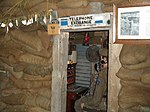CFRC-FM
1922 establishments in OntarioCampus radio stations in CanadaCanadian Radio Broadcasting CommissionQueen's University at KingstonRadio stations established in 1922 ... and 1 more
Radio stations in Kingston, Ontario

CFRC-FM (101.9 MHz) is the non-commercial campus radio station at Queen's University in Kingston, Ontario, Canada. The station has one of the longest radio histories in Canada, with experimental broadcasts dating back to 1922 and serves Queen's University students and faculty as well as the greater Kingston community. CFRC-FM is also a member of the National Campus and Community Radio Association. CFRC-FM has an effective radiated power (ERP) of 3,000 watts. The transmitter is on Station Road in Kingston, near the Macdonald-Cartier Freeway (Ontario Highway 401).
Excerpt from the Wikipedia article CFRC-FM (License: CC BY-SA 3.0, Authors, Images).CFRC-FM
Highway 401, Kingston
Geographical coordinates (GPS) Address Nearby Places Show on map
Geographical coordinates (GPS)
| Latitude | Longitude |
|---|---|
| N 44.29 ° | E -76.431666666667 ° |
Address
Highway 401
K7L 4V3 Kingston
Ontario, Canada
Open on Google Maps


